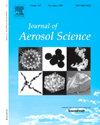Clearance of Particles from Regular-flavored Little Cigar Smoke Across Lung Lobes in Female Sprague-Dawley Rats
IF 3.9
3区 环境科学与生态学
Q2 ENGINEERING, CHEMICAL
引用次数: 0
Abstract
Quantifying the clearance and retention of inhaled particles in the respiratory tract is critical for understanding their toxicity and overall health impacts. While previous studies have focused on the clearance of monodisperse nanoparticles in animal models, limited research exists on the clearance kinetics of tobacco smoke particles. Even fewer studies provide lobe-specific clearance data, which hampers our understanding of smoke particle accumulation following long-term exposure. This gap highlights the need for further research, particularly involving little cigars given their popularity among youth. In this study, we investigated the lobar clearance of smoke particles in rat lungs following exposure to combusted Swisher Sweets regular-flavored little cigars. Twelve-week-old female Sprague-Dawley rats were exposed to smoke particles at a concentration of 80 mg/m3 for 4 hours. Lung lobes were collected and analyzed for particle retention on Days 0, 1, 7, and 21 post-exposure. Inductively Coupled Plasma Mass Spectrometry was used to quantify chromium concentrations in each lobe, serving as a tracer for smoke particles. Our results revealed a two-phase clearance of little cigar smoke particles across all lung lobes, with an overall half-life of 5.7 days for the fast phase and 25.0 days for the slow phase. While no statistically significant differences in particle retention among lobes were observed after 21 days, the majority of retained particles were found in the left lobe and right caudal lobe. When comparing the half-life of smoke particles in this study to previously reported data for nanoparticles, we found the results to be comparable. Our findings demonstrate that the clearance of smoke particles follows a similar pattern across different lung lobes in rats, with a two-phase clearance mechanism indicating that the chromium in the smoke particles likely exists in the Cr (III) oxidation state. These insights provide valuable information for estimating the clearance and retention of little cigar smoke particles, contributing to toxicity research in the context of long-term exposure.
雌性Sprague-Dawley大鼠肺叶中普通口味小雪茄烟雾颗粒的清除
量化吸入颗粒在呼吸道中的清除和滞留对于了解其毒性和整体健康影响至关重要。虽然以往的研究主要集中在单分散纳米颗粒在动物模型中的清除,但对烟草烟雾颗粒清除动力学的研究有限。提供特定肺叶清除数据的研究更少,这阻碍了我们对长期接触后烟雾颗粒积累的理解。这一差距突出了进一步研究的必要性,特别是涉及小雪茄,因为它们在年轻人中很流行。在这项研究中,我们研究了暴露于燃烧的Swisher糖果常规风味小雪茄后大鼠肺中烟雾颗粒的大叶清除。将12周龄雌性Sprague-Dawley大鼠暴露于浓度为80 mg/m3的烟雾颗粒中4小时。在暴露后第0、1、7和21天收集肺叶并分析颗粒滞留情况。电感耦合等离子体质谱法用于量化每个叶中的铬浓度,作为烟雾颗粒的示踪剂。我们的研究结果显示,小雪茄烟雾颗粒在所有肺叶中有两阶段的清除,快速阶段的总半衰期为5.7天,缓慢阶段的总半衰期为25.0天。21天后,各脑叶颗粒滞留量无统计学差异,但大部分颗粒滞留在左脑叶和右脑尾叶。当将本研究中烟雾颗粒的半衰期与先前报道的纳米颗粒数据进行比较时,我们发现结果具有可比性。我们的研究结果表明,烟雾颗粒的清除在大鼠的不同肺叶中遵循类似的模式,具有两相清除机制,表明烟雾颗粒中的铬可能以Cr (III)氧化态存在。这些见解为估计小雪茄烟雾颗粒的清除和保留提供了有价值的信息,有助于长期接触的毒性研究。
本文章由计算机程序翻译,如有差异,请以英文原文为准。
求助全文
约1分钟内获得全文
求助全文
来源期刊

Journal of Aerosol Science
环境科学-工程:化工
CiteScore
8.80
自引率
8.90%
发文量
127
审稿时长
35 days
期刊介绍:
Founded in 1970, the Journal of Aerosol Science considers itself the prime vehicle for the publication of original work as well as reviews related to fundamental and applied aerosol research, as well as aerosol instrumentation. Its content is directed at scientists working in engineering disciplines, as well as physics, chemistry, and environmental sciences.
The editors welcome submissions of papers describing recent experimental, numerical, and theoretical research related to the following topics:
1. Fundamental Aerosol Science.
2. Applied Aerosol Science.
3. Instrumentation & Measurement Methods.
 求助内容:
求助内容: 应助结果提醒方式:
应助结果提醒方式:


